Known in Estonian as “Lagrits,” literally “licorice the garden dormouse (Eliomys quercinus) died out in Estonia in the 1980s, with the last reported sighting dating to 1986.
However the species may also be useful in controlling invasive alien species in coastal areas.
In spite of its name, the garden dormouse’s main habitat is the forest, though it can also be found in fruit-growing regions. It is particularly common in southern Europe. It has distinctive black eye markings and large ears.
Tuul Sepp, professor of animal ecology at the University of Tartu, said intensified agriculture during the Soviet era proved fatal to the species. “There was an increase in all kinds of agricultural poisons, both herbicides and insecticides. In fact, these were very harmful to all of our nature,” Sepp said.
Another casualty of this mismanagement included the European roller, a colorful bird which is a summer visitor to northern Europe.
The garden dormouse too is particularly vulnerable to agricultural poisons, due to its characteristics. Unlike other Estonian rodents, the dormouse, as its name suggests, hibernates. “It curls up and sleeps for up to half a year. Those animals that hibernate must accumulate fat reserves to survive the winter,” Sepp said.
As the species also feeds on insects, toxins can accumulate in its fat tissue that way. During hibernation, these toxins begin to get released from the fat and can make the animal unwell or even prove fatal.
The initiative to bring the species back to Estonian nature was the brainchild of the Lutreola foundation, led by Tiit Maran and Uudo Timm, who had also helped reintroduce the European mink to Estonia. The idea dates back to as long ago as the 1990s, when the pair made a film with noted cinematographer Rein Maran about the last known wild population of dormice found on the Tütarsaared islands, in the Gulf of Finland, before World War Two Finnish territory.
 Garden dormouse and its distinctive appearance. Source: Arno Laurent / CC BY-SA 3.0
Garden dormouse and its distinctive appearance. Source: Arno Laurent / CC BY-SA 3.0
Some years ago around 20 of the mice were brought to Tallinn Zoo from the Netherlands. “The capable zoo experts, led by Kristel Nemvalts, developed solutions on how to keep dormice in captivity in Estonia, how to breed them, and how to create suitable hibernation conditions,” Sepp said of this project.
Once it became clear that the animals could be successfully managed in captivity, the groundwork was laid for reintroducing the species into Estonian nature.
Impact on the ecosystem
While the garden dormouse has been absent from the Estonian ecosystem for decades, it would not become an invasive “alien” species of its own, Sepp argued, referring to the assessment of Merike Linnamäe, a species protection expert at the Ministry of Climate, who considers the likelihood of that risk very low.
“For a start, the dormouse still has many natural predators in Estonia. It is preyed upon by various small predators and birds of prey. It is especially vulnerable during its long hibernation period,” explained the professor. Furthermore, the species’ distribution, despite its name, is confined to uncultivated areas, plus it is a territorial animal which does not tolerate a high population density of its own kind.
Instead, the forest dormouse could benefit Estonian nature, Sepp noted. “According to Merike Linnamäe, there is hope that it could help us control invasive species in coastal areas, as it also gladly eats rose hips, meaning it could limit the spread of rugosa rose on the dunes.”
Farmers and homeowners have no cause for worry either, he said. Sepp provided an example from Germany, which has Europe’s largest garden dormouse population. “The dormouse may move into gardens and occasionally into houses, but it behaves quite differently from a house mouse — it doesn’t chew on items or wires,” Sepp said. The Germans have also developed guidelines on how to gently guide the rodent back into the garden using, for example, strong-smelling oils or even chili.
A slow and empirically-based process
Right now, the project has 40 garden dormice to its name, which have successfully bred this spring. With the help of a campaign on crowdfunding site Hooandja, they hope to build new enclosures to further grow the population. “We probably won’t have more than 60 next year. The first batch we release will be around 20 animals,” Sepp noted. The mice are planned to first be released on an unnamed island in Northern Estonia.
In addition to enclosures, funds are also being raised via Hooandja to monitor the animals in the wild. “We would like to procure tools for monitoring them in nature, such as trail cameras and sound detectors. With these, we can find out whether the animals survive and cope, and whether the population needs further support,” the professor explained. He stressed that reintroduction is a slow, science-based, and labor-intensive process.
If the dormouse project proves successful, scientists already have a new dream lined up. “If things go well with the dormice, there will be a strong temptation to try reintroducing another native dormouse species to Estonia — the hazel dormouse,” revealed Sepp.
The hazel dormouse, or common dormouse (Muscardinus avellanarius), the only living species in the genus Muscardinus, died out in Estonia more recently, in the early 2000s. However it is a more demanding species, preferring nuts as food, as its name suggests, and which are needed to help bulk up before hibernation. Similar experiments are currently underway in England, with the help of citizen scientists.
—
